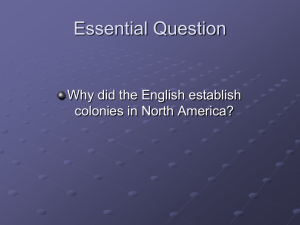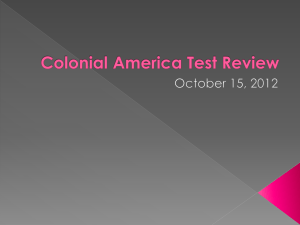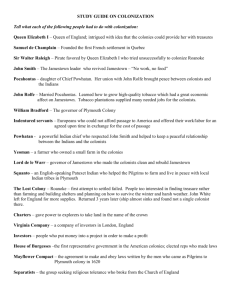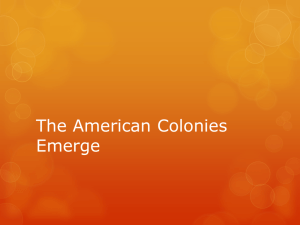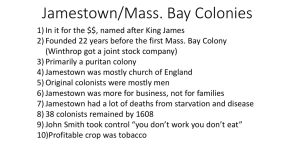Early English Settlement
advertisement
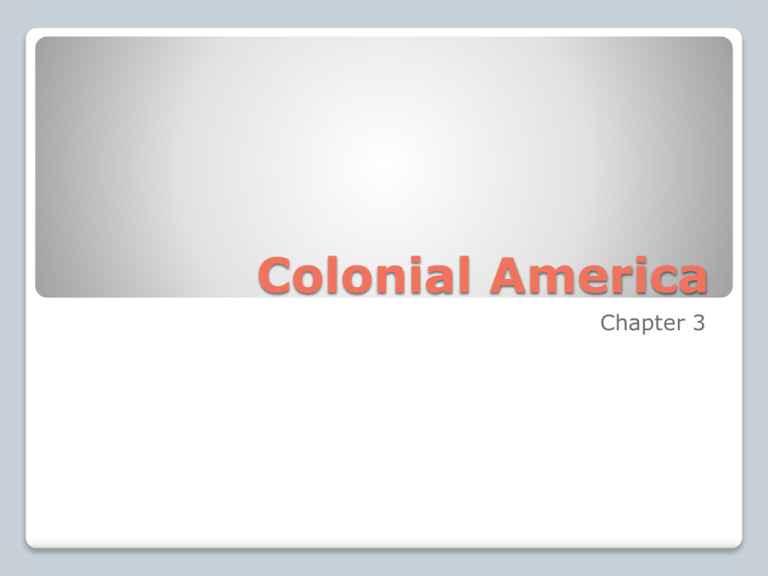
Colonial America Chapter 3 Early English Settlements Chapter 3.1 England in America The Spanish Armada ◦ Spain and England were close to war because of trading and religious rivalries Spain = Catholic (Philip II) England = Protestant (Queen Elizabeth) ◦ Sir Frances Drake (England) attacked ships ◦ Philip sent the Spanish Armada to conquer England, but failed Spain’s control of the seas disappeared England in America Lost Colony of Roanoke ◦ Sir Walter Raleigh granted right to settle land for England ◦ Liked Roanoke Island, off North Carolina ◦ In 1587 a group led by John White settled and met natives ◦ White left for more supplies in England ◦ Returned three years later to an empty island Croatoan carved into a tree, but no attempt to reach Croatoan island Settlers never seen again! Jamestown Settlement Years after the Roanoke failure, several groups sought charters from King James I ◦ Charter: document granting them right to organize settlements in an area. ◦ Virginia Company: A group landed in Chesapeake Bay in 1607 Named the river James and their settlement Jamestown Searching for gold and establishing trade in fish and furs Jamestown Settlement The Virginia Company was a joint-stock company ◦ Investors bought stock (part ownership) in the company ◦ Investors would either make money or lose money based on the results of the company ◦ Similar to the stock market today Supply and demand ◦ Supply: amount of a good that you have ◦ Demand: peoples’ desire for that good ◦ As a business person you want high demand for your goods, and not too large of a supply. Supply: the less supply of a good, the more rare it is…and more people will pay for it Demand: the more demand there is, the more people will pay for it Jamestown Settlement Jamestown Survives…somehow ◦ Conditions not good (malaria and hunger) ◦ People were not making money ◦ Searching for gold ◦ Tried to set up trade with fur and fish ◦ John Smith worked with local Natives and forced colonists to work in order to survive (Pocahontas stories not true) If you don’t work, you don’t eat! Jamestown struggles when he leaves (starving time) Jamestown Settlement Colonists finally found a way to make money…growing tobacco (thanks John Rolfe!). Things improved: ◦ Better relationship with natives ◦ More settlers (headright system) ◦ House of Burgesses makes local laws Financial troubles led to cancelled charter ◦ Jamestown becomes first English colony in 1624 New England Colonies Chapter 3.2 Religious Freedom Unlike Jamestown settlers, many colonists came in search of religious freedom King Henry VIII broke from Catholic Church in 1534 Two groups of Protestants emerge ◦ Puritans: wanted to reform the church ◦ Separatists: wanted to leave church and start their own Separatists were persecuted against ◦ Fled to Netherlands, but wanted an English lifestyle Religious Freedom The Pilgrim’s Journey ◦ Separatists considered themselves Pilgrims because their journey had a religious purpose The Mayflower Compact ◦ Settled in Plymouth due to weather Led by William Bradford Outside of Virginia Company’s territory ◦ Mayflower Compact created pledged loyalty to England agree to obey laws passed “for the general good of the colony” first step in creating a representative government Religious Freedom Help from the Native Americans ◦ Nearly half of the Pilgrims died in the first winter from malnutrition, disease, and cold ◦ Squanto and Samoset helped Pilgrims in the spring Showed them how to grow corn, beans, and pumpkins Showed them where to hunt and fish Helped create peace with the Wampanoag people and their leader, Massasoit Without their help, Pilgrims likely wouldn’t have survived New Settlements King Charles takes the throne in 1625 ◦ Puritans wanted to leave England Massachusetts Bay Company forms in 1629 ◦ Charter to settle near Boston ◦ John Winthrop selected as Governor New Settlements Growth and Government ◦ More than 15,000 Puritans went to Massachusetts during the 1630s (Great Migration) ◦ Government Winthrop and assistants made laws at first Colonists demanded more of a role Elected assembly begins ◦ Male church members voted for governor and town representatives Little tolerance for other beliefs New Settlements Connecticut and Rhode Island ◦ Puritans lack of tolerance forced many to settle elsewhere ◦ Connecticut settlers adopted the Fundamental Orders of Connecticut First written Constitution discussing the organization of a representative government ◦ Rhode Island established by Roger Williams Believed in religious tolerance (religion out of government) Believed it was wrong to take land from natives New Settlements Conflict with Native Americans ◦ Many settlements were on Native American land, which led to conflict ◦ King Philip’s War Metacomet, Chief of the Wampanoag, organized rebellion against colonists Colonists were victorious, destroyed much of the natives’ power in the area ◦ Colonists have the freedom to expand in new lands Middle Colonies Chapter 3.3 England and the Colonies Oliver Cromwell leads groups of Puritans seeking more power in Parliament Takes over the government in 1649 Wants new land for England between the colonies they already own Middle colonies become the most ethnically diverse set of colonies England and the Colonies England Takes Over ◦ New Amsterdam becomes a target for England Already owned by Dutch Great port and rivers for trade 1664: fleet of English ships take over New Amsterdam ◦ Duke of York (Charles’ brother) given land and complete control Colony thrives England and the Colonies New Jersey ◦ Duke of York gives southern portion of his colony to Lord John Berkeley and Sir George Carteret Name it New Jersey Proprietors of the land: complete control ◦ To attract settlers they promised: Freedom of religion Trial by jury Representative assembly (in charge of taxes and laws) ◦ No natural ports = no big profits Pennsylvania William Penn given land as payment for a debt Saw Pennsylvania as a chance to spread Quaker beliefs: ◦ Everyone is equal ◦ Pacifists ◦ “inner light” to salvation Philadelphia established on Native American land, but paid for Quakers also known as Society of Friends Charter of Liberties (1701) gave people the right to elect representatives Southern Colonies Chapter 3.4 Maryland and Virginia As plantations grew, so did the need for workers People sent over to work included: ◦ Criminals: could earn a release after seven years ◦ Slaves: African prisoners of war sold to European slave traders ◦ Indentured servants: worked without pay for a set amount of time in order to get to colonies Maryland and Virginia Establishing Maryland ◦ Sir George Calvert (Lord Baltimore) wanted to establish Maryland as a safe place for Catholics ◦ Estates given to numerous people, population grew ◦ Conflict with Penn over boundary led to the Mason Dixon Line ◦ Protestants outnumber the Catholics and take control Catholics face the same restrictions they did in England Maryland and Virginia Bacon’s Rebellion ◦ Virginia’s growth led to a deal with Native Americans (chunk of land given to colonists and colonists won’t expand west) ◦ Nathaniel Bacon opposed the deal Leads rebellion against natives and Jamestown rulers Exiled William Berkeley, as leader, for a brief bit ◦ Bacon’s sudden death stopped complete take over, and things returned to normal ◦ Rebellion showed that colonists would not settle for staying along the coast Carolinas and Georgia Northern and Southern Carolina ◦ Two colonies form after a split in philosophy ◦ Both colonies created for profit: North: tobacco, timber, and tar (used Virginia harbor) South: deerskin, lumber, and beef Two dominant crops for both: ◦ Rice (which led to more slaves) ◦ Indigo Carolinas and Georgia Georgia ◦ James Oglethorpe given a charter to start a colony in the south for two purposes: Debtors get a fresh start Protection from Spain ◦ Things did not go according to plan: Very poor people came in large amounts People hated Oglethorpe’s rules


